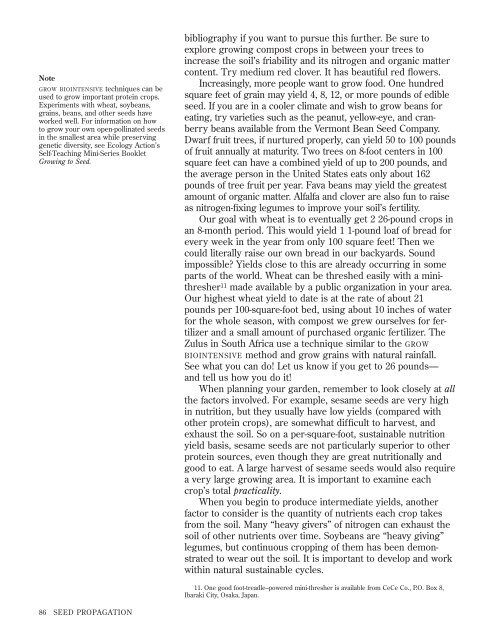How to Grow More Vegetables : And Fruits, Nuts ... - Shroomery
How to Grow More Vegetables : And Fruits, Nuts ... - Shroomery
How to Grow More Vegetables : And Fruits, Nuts ... - Shroomery
You also want an ePaper? Increase the reach of your titles
YUMPU automatically turns print PDFs into web optimized ePapers that Google loves.
Note<br />
GROW BIOINTENSIVE techniques can be<br />
used <strong>to</strong> grow important protein crops.<br />
Experiments with wheat, soybeans,<br />
grains, beans, and other seeds have<br />
worked well. For information on how<br />
<strong>to</strong> grow your own open-pollinated seeds<br />
in the smallest area while preserving<br />
genetic diversity, see Ecology Action’s<br />
Self-Teaching Mini-Series Booklet<br />
<strong>Grow</strong>ing <strong>to</strong> Seed.<br />
86 SEED PROPAGATION<br />
bibliography if you want <strong>to</strong> pursue this further. Be sure <strong>to</strong><br />
explore growing compost crops in between your trees <strong>to</strong><br />
increase the soil’s friability and its nitrogen and organic matter<br />
content. Try medium red clover. It has beautiful red flowers.<br />
Increasingly, more people want <strong>to</strong> grow food. One hundred<br />
square feet of grain may yield 4, 8, 12, or more pounds of edible<br />
seed. If you are in a cooler climate and wish <strong>to</strong> grow beans for<br />
eating, try varieties such as the peanut, yellow-eye, and cranberry<br />
beans available from the Vermont Bean Seed Company.<br />
Dwarf fruit trees, if nurtured properly, can yield 50 <strong>to</strong> 100 pounds<br />
of fruit annually at maturity. Two trees on 8-foot centers in 100<br />
square feet can have a combined yield of up <strong>to</strong> 200 pounds, and<br />
the average person in the United States eats only about 162<br />
pounds of tree fruit per year. Fava beans may yield the greatest<br />
amount of organic matter. Alfalfa and clover are also fun <strong>to</strong> raise<br />
as nitrogen-fixing legumes <strong>to</strong> improve your soil’s fertility.<br />
Our goal with wheat is <strong>to</strong> eventually get 2 26-pound crops in<br />
an 8-month period. This would yield 1 1-pound loaf of bread for<br />
every week in the year from only 100 square feet! Then we<br />
could literally raise our own bread in our backyards. Sound<br />
impossible? Yields close <strong>to</strong> this are already occurring in some<br />
parts of the world. Wheat can be threshed easily with a minithresher<br />
11 made available by a public organization in your area.<br />
Our highest wheat yield <strong>to</strong> date is at the rate of about 21<br />
pounds per 100-square-foot bed, using about 10 inches of water<br />
for the whole season, with compost we grew ourselves for fertilizer<br />
and a small amount of purchased organic fertilizer. The<br />
Zulus in South Africa use a technique similar <strong>to</strong> the GROW<br />
BIOINTENSIVE method and grow grains with natural rainfall.<br />
See what you can do! Let us know if you get <strong>to</strong> 26 pounds—<br />
and tell us how you do it!<br />
When planning your garden, remember <strong>to</strong> look closely at all<br />
the fac<strong>to</strong>rs involved. For example, sesame seeds are very high<br />
in nutrition, but they usually have low yields (compared with<br />
other protein crops), are somewhat difficult <strong>to</strong> harvest, and<br />
exhaust the soil. So on a per-square-foot, sustainable nutrition<br />
yield basis, sesame seeds are not particularly superior <strong>to</strong> other<br />
protein sources, even though they are great nutritionally and<br />
good <strong>to</strong> eat. A large harvest of sesame seeds would also require<br />
a very large growing area. It is important <strong>to</strong> examine each<br />
crop’s <strong>to</strong>tal practicality.<br />
When you begin <strong>to</strong> produce intermediate yields, another<br />
fac<strong>to</strong>r <strong>to</strong> consider is the quantity of nutrients each crop takes<br />
from the soil. Many “heavy givers” of nitrogen can exhaust the<br />
soil of other nutrients over time. Soybeans are “heavy giving”<br />
legumes, but continuous cropping of them has been demonstrated<br />
<strong>to</strong> wear out the soil. It is important <strong>to</strong> develop and work<br />
within natural sustainable cycles.<br />
11. One good foot-treadle–powered mini-thresher is available from CeCe Co., P.O. Box 8,<br />
Ibaraki City, Osaka, Japan.












